 Fashions at Suppertime 1926
Fashions at Suppertime 1926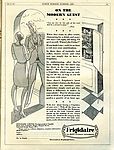 Refrigerator advertisement, Punch, May 26 1930
Refrigerator advertisement, Punch, May 26 1930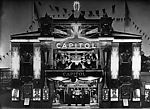 Capitol Cinema, London, 1937
Capitol Cinema, London, 1937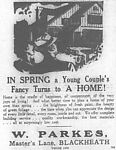 Advertisement from County Express, March 1837
Advertisement from County Express, March 1837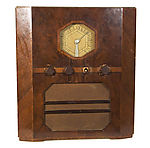 McMichael radio, 1930s, held at Black Country Living Museum
McMichael radio, 1930s, held at Black Country Living Museum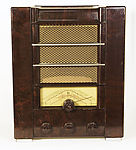 G.E.C. bakelite radio, 1936, held at Black Country Living Museum
G.E.C. bakelite radio, 1936, held at Black Country Living Museum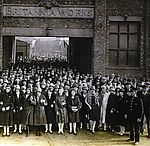 Workers at the Revo factory wearing the fashions of the day, 1920s
Workers at the Revo factory wearing the fashions of the day, 1920s

The period between the wars was one of contrasts; mass unemployment, dole queues, hunger marches and the means test; on the other hand it was a time of higher wages for those lucky enough to have jobs, a boom in housing, a rapid increase in car ownership and the availability of cheaper consumer goods. An individual's experience during the period depended, to a large extent on who they were, where they lived and what their occupation was.
Perhaps the most well-known image of the 1920s is that of the "flapper", a freedom-loving, social butterfly, for whom life was a whirl of endless parties. Flappers horrified their elders and dazzled young men by wearing shockingly short dresses, chopping off their hair into a boyish "Eton Crop", visiting bars and public houses and smoking in public. Flappers were seen on motorbikes, riding on the pillions known as "flapper brackets". All in all they were much more "brazen" than women were supposed to be.
From 1926 on, hair and skirts began to grow longer again, and after 1929 and the Depression that followed it, fashion changed quite sharply. Hemlines dropped almost overnight. By the end of the 1930s one distinctively "Thirties Look" had emerged: padded shoulders; tailored, slightly mannish suits; and hats that looked a little like men’s trilbies. Hair was longer again and generally pinned up on the head. This style was fixed by the years of the Second World War and did not change again until the post-war "New Look".
While the image of the "flapper" was only true of wealthy women, the First World War had brought many changes to ordinary women's lives. Women, who had tended wounded men, risked their lives in munitions factories and worked all weathers on the land, were not going to give up their new-found independence easily. Social attitudes became more relaxed.
Nevertheless, many women faced an uncertain future. The losses experienced in the First World War left many families without a breadwinner. With women greatly outnumbering men, many would never marry, having to support themselves and, perhaps, aging parents. Growing numbers worked outside the home, especially in secretarial and clerical work, in the retail trade, in textiles and in the newer light industries. The problem of survival became more pressing as economic depression took hold of the country in the early 1930s, the worst hit areas being the North, industrial Scotland and South Wales. Men working in heavy industry were the worst hit by unemployment.
The period saw the building of more houses in Britain than at any other time. Four million flats and houses were built between 1918 and 1939, about half of them for sale, and most of the rest rented from local authorities. These new homes had electricity, hot and cold running water, separate kitchens and bathrooms and indoor lavatories.
Eating habits in Britain remained conservative. Most people expected a meal of meat, potatoes and vegetables each day. Some tropical fruits were being imported by the end of the period, but vegetables such as peppers, courgettes and aubergines were rare and considered to be very exotic. Eating out was an occasional treat for some families. The grand restaurants in Britain were well beyond the means of ordinary people, but the opening of Lyon's Corner Houses made it possible to eat inexpensive meals, in quite splendid surroundings, served by "nippies", waitresses smartly dressed in black dresses with white caps and aprons.
People had a better understanding of the importance of vitamins, minerals and proteins in their diet, but for those affected by unemployment, there was little opportunity to put their knowledge into practice. Almost a tenth of the population suffered from malnutrition.
This was also the period of mass leisure and entertainment, with people having shorter working hours, and more disposable income. Women's magazines came into their own at this time. "Woman", the most successful British magazine, was selling three-quarters of a million copies in 1939. The introduction of the Penguin paperback brought reading and self-improvement within the means of all but the poorest.
From the mid 1920s, a favourite evening's entertainment for millions of families was listening to the radio. The wireless set, still a large piece of equipment until portables appeared in the late 1930s, dominated the living room.
The old music hall barely survived the First World War and the advent of cinema. By 1930 there were 5000 cinemas in Britain. Seats were cheap at 6d (2 ½p). Popcorn and ice-creams were sold, and smoking was allowed throughout the performances. Films were often viewed through a haze of smoke.
The 1920s and 1930s were also the "dancing years", when young people flocked to dance halls and jazz clubs. Popular dances included the Charleston, the Shimmy and the Blackbottom. Many dance halls banned the Jitterbug dance, because some of the more spirited young women revealed too much of themselves while they were doing it.
During the period, more people were given paid holidays and many spent their holiday away from home. In Britain, by the late 1930s more than 20 million visitors a year were going to seaside resorts. Blackpool, whose famous "illuminations" became a permanent feature in 1925, had a resident population of 100,000 with seven million visitors a year by 1931. On one Bank holiday in 1937 it had over half a million visitors, who arrived in 50,000 motor vehicles and 700 trains.
The inter-war years were also the age of the holiday camp, which originated in America, and offered "all-in" holidays based on individual chalets and communal dining rooms. In Britain, William Butlin opened the first commercial holiday camp at Skegness in 1936. There were 200 holiday camps in Britain by 1939, all offering accommodation, food and organised entertainment for as little as £2.00 to £3.00 a day.
Rollover the captions in the box to see the available images in thumbnail format, click the caption to see the full-size image
| Reference: | 748 |
| Keywords: | |
| Archive Ref: | |
| Updated: | Thu 22 May 2008 - 1 |
| Interpretation written by | Barbara Harris |
| Author's organisation | |
| Organisation's website |